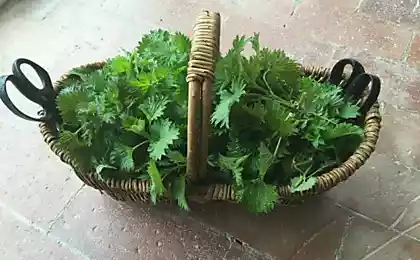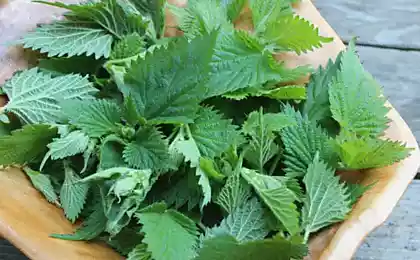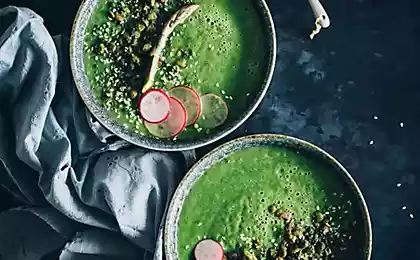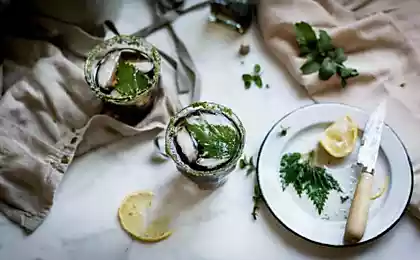463
Clothing from nettles
In Russia from time immemorial were craftsmen who have weaving and spinning from everything that under a hand came across: fireweed, thistles, burdock, quinoa, and even boiled pine needles. In the old days known was the so-called "wood wool" – a fibrous material extracted from the pine needles. To get "pine wool" needle was steamed out, boiled in lye, combed, washed and dried. The obtained fibers were used to make warm knitted things. "Pine" clothing is considered not only warm, but also very useful to prevent rheumatism.
Nettle also did fabric. They were fairly common.

Nettles for spinning is harvested in the spring. It's ready trust, the quality of which was underlined by the very nature of autumn rains and fogs, winter frost and spring thaw.
Of long, thin fibers – tow – woven dense canvases and then sewed tunics, shirts, towels, bed linen – everything you need for a decent dowry. Canvas bleached in the dew and snow, boiled in the decoction of wood ash or tinted decoction of chamomile and cornflowers.
From short and coarse fibers are Ishiba and Picasa – woven rough and rare tracks – the so-called rednano, which was in bags, blankets, bedding and cushion loads.
Of spun fibres twisted ropes and cables. First fiber during the day was soaked in the decoction of oak bark for strength. Then divided into two parts, one of which was stained black broth of rusty moss. Twisted fibers of two colors of rope amazed by the intricate and unique pattern!
Flax, hemp, bamboo, nettles have antiseptic, antifungal, relieves electrostatics. For the urban man this outfit is a step towards nature.

Waste of nettles was used as a tow — for laying between the logs and sealing of cracks in the construction of the new house. From the nettle yarn used to knit coarse socks-Slippers, which were worn without removing for rheumatism, belts, warming the lower back with sciatica and a beanie from the appearance which the head passed any migraines.
Nettle has several advantages over flax.
— First, the yarn from it is softer because it is not from the leaves, and hollow stems.
— Secondly, due to the cavity it has better conductivity than flax. It is cooler in the summer and warmer in winter.
— Thirdly, the yarn of nettle flax is much cheaper and the process of its production is not so much pollute the environment.
Like flax and hemp, nettle is one of the oldest fiber plants which man has learned to handle.
Now nettles and other plants were replaced by linen and cotton, which is grown on an industrial scale and in large quantities. But the cultivation of cotton and causes great harm to the environment! About a quarter of all pesticides used in the world, used on cotton plantations, depleting the soil, polluting the air and water! In addition, the cotton only grows in a particular climate, it has to be transported great distances.
Nettle is much softer, thinner, silkier and more supple hemp be cheaper to grow and produce than flax, and about the environmental side of the issue and say nothing. What are the chemicals, fertilizers, specific climate – it's weed! Nettle is not terrible nor rain nor drought, just give her the will – cover their thickets of the entire territory of Europe. And in these thickets here you will find the shelter more than 40 types of insects and small birds.
Last year, the Italian fashion House Corpo Nove has started production of clothing from nettles. The first fabrics were made of nettle German Rhineland. Jacket and jeans from nettle are a stunning success. After all, in addition to the exotic raw materials used new clothes have a therapeutic effect – relieves attacks of rheumatism and relieves allergic reactions. Released a collection of jeans, jackets, skirts and shirts. Burn the clothing is impossible, as the production does not use stinging hairs. The main concern of designers now is to find farmers who believe that the cultivation of this weed can be beneficial not only environmentally, but also economically.
In fairness it should be said that nettle fibres were forgotten not all adults. Even today they are used for spinning thread, preferring the purchase, the indigenous residents of Kamchatka and the Amur region. Strong and durable threads are going to weave bags, baskets and a variety of boxes.
In the manufacture of traditional products along with nettle threads used willow twigs, stems of wild rye (tawaki) and birch. Quite frequently used and more fibrous plant that grows on vacant lots and burned areas, fireweed uzkolisty, called Ivan-tea. Harvested in autumn the stalks of fireweed carefully remove the skin, divide it into fiber, dried, and removed for storage.
Part of the harvested material is dyed in a decoction collected in the swamp of rusty moss, containing oxide of iron, in black color. To give the fiber luster, the coloring solution is added fish oil. Alternating in a certain order of dark and light fibers, wizard, decorate the surface in geometric patterns.published
Author: Vika Volkova
P. S. And remember, only by changing their consumption — together we change the world! © Join us at Facebook , Vkontakte, Odnoklassniki
Source: vk.com/feed?w=wall-55961955_4771
Nettle also did fabric. They were fairly common.

Nettles for spinning is harvested in the spring. It's ready trust, the quality of which was underlined by the very nature of autumn rains and fogs, winter frost and spring thaw.
Of long, thin fibers – tow – woven dense canvases and then sewed tunics, shirts, towels, bed linen – everything you need for a decent dowry. Canvas bleached in the dew and snow, boiled in the decoction of wood ash or tinted decoction of chamomile and cornflowers.
From short and coarse fibers are Ishiba and Picasa – woven rough and rare tracks – the so-called rednano, which was in bags, blankets, bedding and cushion loads.
Of spun fibres twisted ropes and cables. First fiber during the day was soaked in the decoction of oak bark for strength. Then divided into two parts, one of which was stained black broth of rusty moss. Twisted fibers of two colors of rope amazed by the intricate and unique pattern!
Flax, hemp, bamboo, nettles have antiseptic, antifungal, relieves electrostatics. For the urban man this outfit is a step towards nature.

Waste of nettles was used as a tow — for laying between the logs and sealing of cracks in the construction of the new house. From the nettle yarn used to knit coarse socks-Slippers, which were worn without removing for rheumatism, belts, warming the lower back with sciatica and a beanie from the appearance which the head passed any migraines.
Nettle has several advantages over flax.
— First, the yarn from it is softer because it is not from the leaves, and hollow stems.
— Secondly, due to the cavity it has better conductivity than flax. It is cooler in the summer and warmer in winter.
— Thirdly, the yarn of nettle flax is much cheaper and the process of its production is not so much pollute the environment.
Like flax and hemp, nettle is one of the oldest fiber plants which man has learned to handle.
Now nettles and other plants were replaced by linen and cotton, which is grown on an industrial scale and in large quantities. But the cultivation of cotton and causes great harm to the environment! About a quarter of all pesticides used in the world, used on cotton plantations, depleting the soil, polluting the air and water! In addition, the cotton only grows in a particular climate, it has to be transported great distances.
Nettle is much softer, thinner, silkier and more supple hemp be cheaper to grow and produce than flax, and about the environmental side of the issue and say nothing. What are the chemicals, fertilizers, specific climate – it's weed! Nettle is not terrible nor rain nor drought, just give her the will – cover their thickets of the entire territory of Europe. And in these thickets here you will find the shelter more than 40 types of insects and small birds.
Last year, the Italian fashion House Corpo Nove has started production of clothing from nettles. The first fabrics were made of nettle German Rhineland. Jacket and jeans from nettle are a stunning success. After all, in addition to the exotic raw materials used new clothes have a therapeutic effect – relieves attacks of rheumatism and relieves allergic reactions. Released a collection of jeans, jackets, skirts and shirts. Burn the clothing is impossible, as the production does not use stinging hairs. The main concern of designers now is to find farmers who believe that the cultivation of this weed can be beneficial not only environmentally, but also economically.
In fairness it should be said that nettle fibres were forgotten not all adults. Even today they are used for spinning thread, preferring the purchase, the indigenous residents of Kamchatka and the Amur region. Strong and durable threads are going to weave bags, baskets and a variety of boxes.
In the manufacture of traditional products along with nettle threads used willow twigs, stems of wild rye (tawaki) and birch. Quite frequently used and more fibrous plant that grows on vacant lots and burned areas, fireweed uzkolisty, called Ivan-tea. Harvested in autumn the stalks of fireweed carefully remove the skin, divide it into fiber, dried, and removed for storage.
Part of the harvested material is dyed in a decoction collected in the swamp of rusty moss, containing oxide of iron, in black color. To give the fiber luster, the coloring solution is added fish oil. Alternating in a certain order of dark and light fibers, wizard, decorate the surface in geometric patterns.published
Author: Vika Volkova
P. S. And remember, only by changing their consumption — together we change the world! © Join us at Facebook , Vkontakte, Odnoklassniki
Source: vk.com/feed?w=wall-55961955_4771
What is the use of raisins for Your health
Ruslan Bayramov: If around quietly, so you aimlessly living my life























